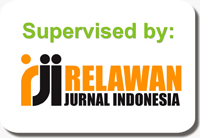Komparasi Performansi Antara Proportional Integral Derivative Controller (PID) Dan Fuzzy Logic Controller (FLC) Pada Penjejak Cahaya Dengan Tiga Sensor
DOI:
https://doi.org/10.31961/eltikom.v6i2.552Keywords:
FLC, Light Tracking, PIDAbstract
The technology of light tracking monitors the solar panels to track the sun with full efficiency, and the solar panels can be upright to the sunlight in order to maximize the absorption of solar energy, so this system has a higher efficiency than non-tracking systems. This study aimed to obtain a controller that works accurately between the Proportional, Integral, and Derivative Controller (PID) and the Fuzzy Logic Controller (FLC) Algorithm by comparing the performance of the two algorithms in regulating the direction of the light tracker to detect the presence of sunlight. This solar prototype uses nine lamps as a simulation to determine the accuracy and precision of the angles of the two light trackers. The parameters compared in this test were the aspects of angular velocity and angle accuracy. The mean value of angular velocity obtained from the PID light tracking test results was 0.16 rad/s and the average linear velocity was 0.092 m/s whereas in the FLC light tracker, the average angular velocity value was 0.207 rad/s. Tests using a PID light tracker resulted in an X-axis accuracy of 45% and a Y-axis accuracy of 30%. The FLC light tracker, on the other hand, had an X-axis accuracy of 80% and a Y-axis accuracy of 30%.The precision value obtained by the PID light tracker on the X axis was 45% and the Y axis was 38%, while the precision value obtained by the FLC light tracker on the X axis was 71% and the Y axis was 33%. Based on the overall calculations, it can be concluded that the FLC light tracker has an increase in the speed value of 29% and an increase in the value of accuracy in the accuracy aspect by 35% and the precision aspect by 26% compared to the PID light tracker in previous studies.
Downloads
References
Y. Away, Suriadi, A. Rahman, T. R. A. Isma, and Muhammad Firdaus, “Penerapan Logika Fuzzy pada Sun Tracker Dual Axis Ber-basis Sensor Tetrahedron Geometri,†in Seminar Nasional dan Expo Teknik Elektro, 2017, pp. 74–80.
Y. Away, A. Rahman, T. R. A. Isma, and Muhammad Firdaus, “Performance Comparison Between PID and Fuzzy Algorithm for Sun Tracker Based on Tetrahedron Geometry Sensor,†in International conference on Electrical Engineering and informatics, 2018, pp. 40–44.
E. Kiyak and G. Gol, “A Comparison of Fuzzy Logic and PID Controller for A Single-Axis Solar Tracking Sistem,†Renewables Wind. Water Sol. a Springer Open J., vol. 3, no. 7, pp. 1–14, 2016.
C. Hilman and A. Musyafa´, “Rancang Bangun Dual-Axis PV Solar Tracker System Menggunakan Interval Type-2 Fuzzy Logic Con-troller,†in Seminar Nasional Pasca Sarjana FTI-ITS Surabaya, 2014, pp. 1–7.
B. M. Hamed and M. S. El-Moghany, “Fuzzy controller design using FPGA for photovoltaic maximum power point tracking,†Int. J. Adv. Res. Artifcial Intell., vol. 1, no. 3, pp. 14–21, 2012.
Abdul Adhim, “Perancangan Sistem Kontrol Dual-Axis Pv Solar System Menggunakan Particle Swarm Optimization,†S2 Teknik Fisika. FTI-ITS. Surabaya, 2014.
I. Abadi, “Design and Implementation of Active Two Axes Solar Tracking System Using Particle Swarm Optimization Based Fuzzy Logic Controller,†Int. Rev. Model. Simulations, vol. 8, no. 6, pp. 265–272, 2015.
D. Bawa and C. Y. Patil, “Fuzzy control based solar tracker using Arduino Uno,†Int. J. Eng. Innov. Technol., vol. 2, no. 12, pp. 179–187, 2013.
M. S, S. B, and K. R. P, “A new MPPT Design Using Grey Wolf Optimization Technique For PhotoVoltaic System Under partial Shad-ing Conditions,†IEEE Trans. Suistable Energy, vol. 7, pp. 181–188, 2016.
S. Degeratu, S. Rizescu, L. Alboteanu, C. Caramida, P. Rotaru, and I. Boncea, “Using a Shape Alloy Memory Spring Actuator to In-crease the Performance of Solar Tracking System,†Ann. Univ. Craiova, no. 38, pp. 116–121, 2014.
R. Maulana, M. H. H. Ichsan, and Gembong Edhi Setyawan, “Implementasi Pengkondisian Kipas dan Lampu Otomatis Menggunakan Logika Fuzzy,†J. PTIIK, vol. 2, no. 11, pp. 5301–5309, 2018.
A. U. Azmi, Sumardi, and M. A. Riyadi, “Sistem Tracking Panel Surya Untuk Pengoptimalan Daya Menggunakan Metode Kontrol Self-Tuning PID Dengan JST Jenis Perceptron,†J. Transm., vol. 17, no. 1, pp. 35–41, 2015.
B. E. Cahyono, I. D. Utami, and N. P. Lestari, “Karakteristik Sensor LDR dan Aplikasinya pada Alat ukur Tingkat kekeruhan Air Ber-basis Arduino UNO,†J. Teor. dan Apl. Fis., vol. 7, no. 2, pp. 179–185, 2019.
I. Stamatescu, I. Fagarasan, G. Stamatescu, N. Arghira, and S. S. Iliescu, “Design and implementation of a solar tracking algorithm,†in Proceedings of the 24th DAAAM international symposium on intelligent manufacturing and automation, 2014, pp. 500–507.
Sumathi, V., Kanagaraj, J., Reddy, S.S.C., Kankipati, S.S., Vidavaluru, A. and Subramaniam, U., "Dual-Axis Solar Tracking and Moni-toring of Solar Panel Using Internet of Things." Cyber-Physical Systems and Industry 4.0: Practical Applications and Security Man-agement, pp. 137-148, 2022.
Wu, C.H., Wang, H.C. and Chang, H.Y., "Dual-axis solar tracker with satellite compass and inclinometer for automatic positioning and tracking." Energy for Sustainable Development 66. pp 308-318, 2022.
Alvarez-Herrera, C. "Construction of dual-axis sun tracker controlled by Arduino." Journal of Physics: Conference Series. vol. 1723. no. 1, 2021.
Downloads
Published
How to Cite
Issue
Section
License
Copyright (c) 2022 Jurnal ELTIKOM : Jurnal Teknik Elektro, Teknologi Informasi dan Komputer

This work is licensed under a Creative Commons Attribution-NoDerivatives 4.0 International License.
All accepted papers will be published under a Creative Commons Attribution 4.0 International (CC BY 4.0) License. Authors retain copyright and grant the journal right of first publication. CC-BY Licenced means lets others to Share (copy and redistribute the material in any medium or format) and Adapt (remix, transform, and build upon the material for any purpose, even commercially).




